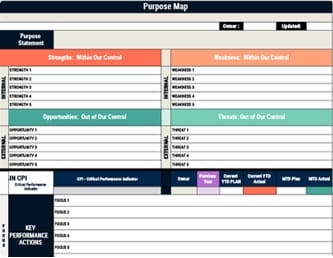Like a GPS that recalibrates when you miss a turn, a performance scorecard helps you correct course by translating strategy into measurable actions, so you don’t drive blind. You’ll align goals across finance, customers, processes, and learning, define clear KPIs and targets, and automate data flows to expose bottlenecks fast. With strategy maps, cascaded scorecards, and governance that links analysis to initiatives, you can create accountability—and uncover what most organizations miss next.
Key Takeaways
- Build a Balanced Scorecard linking financial, customer, process, and learning goals to specific KPIs with clear owners.
- Integrate and automate data into a single source of truth for near real-time KPI updates and consistent definitions.
- Use a strategy map to align objectives, show cause-and-effect linkages, and prioritize initiatives that move key measures.
- Run cadence-based performance reviews that convert KPI variances into actions, resource shifts, deadlines, and documented governance.
- Continuously refine processes using insights to remove bottlenecks, tighten SLAs, and benchmark against competitors for operational excellence.
Why Performance Metrics Drive Behavior and Results
Although metrics can seem like simple numbers, they shape behavior because they translate strategy into clear expectations, visible progress, and concrete accountability.
When you set performance metrics tied to organizational goals, you tell people what matters, how it will be judged, and when results are due, which directs effort and reduces ambiguity. Clear key performance indicators (KPIs) reveal whether daily work supports strategic objectives, while data-driven insights show what’s working and where to adjust in real time.
Tie metrics to goals to focus effort, reduce ambiguity, and guide real-time strategic adjustments.
You motivate teams by making gaps visible: comparing actual to target uncovers bottlenecks, triggers timely action, and improves operational efficiency.
Scorecards centralize KPIs, helping you prioritize projects, allocate resources, and align routines with strategy. Over time, transparent feedback loops normalize continuous improvement and reinforce disciplined execution.
From Legacy Metrics to Modern Strategy Management
One clear shift defines modern strategy management: you move from narrow, legacy metrics that overemphasize short-term financials to a balanced system that links strategy to daily execution.
You replace isolated financial performance measures with an integrated set of performance measures that reflect how value is created end to end, using key performance indicators that tie customer outcomes, internal processes, and learning to results.
The Balanced Scorecard helps you translate strategy into measurable objectives, align teams, and monitor organizational performance without letting ROI or EPS dominate decisions.
Because over half of major companies use it, you can confidently adopt it to integrate financial and non-financial signals, expose trade-offs early, and steer continuous improvement, advancing strategic management and operational excellence in a disciplined, repeatable way.
Balanced Scorecard Essentials and Perspectives
Start with four clear lenses: the Balanced Scorecard organizes strategy execution around the financial, customer, internal process, and learning and growth perspectives, giving you a structured way to define what success looks like and how to measure it.
You use the balanced scorecard to connect strategic goals to day‑to‑day work, translating broad aims into focused performance measurement that reaches every level.
Within each perspective, select key performance indicators (KPIs) that reveal progress: revenue growth and margin for finance, customer satisfaction and retention for the customer view, cycle time and quality for internal processes, and capability building for learning and growth.
Cascade these measures to teams so accountability is clear, decisions are informed, and trade‑offs are explicit, enabling organizational success across functions and time horizons.
Defining Strategic Objectives, KPIs, and Targets
Clarity drives execution, so begin by translating your vision and mission into a concise set of strategic objectives that articulate where you’re going and why it matters. Then link each objective to a small number of relevant KPIs that quantify progress and expose trade‑offs.
Define organizational goals in plain language, state the outcome you seek, and choose key performance indicators (KPIs) that directly test whether you’re moving the needle. Set targets that are ambitious yet realistic, using baselines and benchmarks to guide measurement.
Review and recalibrate regularly to reflect shifts in the business environment, and cascade the balanced scorecard (BSC) so departments and individuals own aligned metrics. Use disciplined performance management routines to track results, learn quickly, and correct course.
- Select few, essential KPIs per objective
- Convert strategy into measurable outcomes
- Set time-bound, evidence-based targets
- Cascade metrics to drive accountability
Building a Strategy Map That Aligns the Enterprise
Blueprint in hand, you’ll translate strategy into a single strategy map that aligns the enterprise by laying out clear objectives across the four Balanced Scorecard perspectives—financial, customer, internal process, and learning and growth—and showing how they connect.
You’ll define strategic objectives in each perspective, then draw cause‑and‑effect linkages that clarify how process improvements and capability building drive customer outcomes and financial results, reinforcing alignment and focus.
Treat the strategy map as a management tool: attach performance measures to each objective so you can test assumptions, expose gaps, and prioritize initiatives that lift organizational performance.
Use the strategy map to test assumptions, reveal gaps, and focus initiatives that boost performance.
Keep language and visuals simple so employees understand goals and trade‑offs.
Review the map regularly, updating objectives and measures as market conditions shift, ensuring the balanced scorecard remains relevant and execution stays on track.
Cascading Scorecards for Line‑of‑Sight and Accountability
While the enterprise strategy map sets direction, cascading scorecards turn it into concrete action by translating top‑level objectives into specific, measurable targets for divisions, departments, teams, and roles, creating a direct line of sight from daily work to strategic outcomes.
You convert strategic objectives into operational performance measures, define owners, and set time-bound targets, so every unit knows how its work advances organizational goals. This structure builds accountability because responsibilities and thresholds are explicit, reviews are routine, and corrective actions are clear.
You also strengthen alignment, since departmental choices reflect shared priorities, reducing conflicting initiatives and siloed decisions, while continuous review improves operational effectiveness.
- Translate strategy into unit-level targets with clear owners and timelines.
- Define a consistent set of performance measures across tiers.
- Hold structured reviews that trigger timely course corrections.
- Calibrate targets to maintain stretch, feasibility, and cross-functional alignment.
Data Integration and Automation for Real‑Time Insights
Because scorecards are only as good as the data behind them, you should integrate sources across your ERP, CRM, production systems, and service tools into a single source of truth. Then automate collection and refresh so KPIs update in near real time.
Use disciplined data integration to standardize definitions, map fields, and reconcile timeframes, ensuring key performance indicators (KPIs) and performance measures mean the same thing across teams.
Apply automation to extract, transform, and load data on reliable schedules, then monitor pipelines for failures.
Leverage an Operations Decision Engine to align metrics across processes, producing real-time insights that expose bottlenecks and lift operational efficiency.
Present results with Python D3, Tableau, or Power BI, tailoring visuals to each audience to speed decision-making, highlight trends, and support benchmarking against competitors.
Turning Analysis Into Action: Initiatives and Governance
Even with strong analytics in place, you only release value when you translate insights into owned initiatives under clear governance.
Define roles, decision rights, and escalation paths so performance measures connect directly to strategic objectives, and assign clear owners for each initiative.
Use data-driven insights to set targets, sequence work, and allocate resources, while scheduling regular reviews to test assumptions and track accountability.
Build feedback loops that capture new signals, enable continuous adjustment, and keep stakeholder engagement high through transparent communication.
- Link each initiative to a specific KPI and strategic objective, naming a single accountable owner.
- Run cadence-based reviews that convert scorecard variances into actions, deadlines, and resourcing shifts.
- Document governance workflows, including approvals, risks, and escalation criteria.
- Share outcomes widely, inviting stakeholder feedback to refine plans and sustain momentum.
Case Examples: Efficiency, Pricing, and Process Improvement
Although scorecards are versatile, their impact is clearest in concrete use cases that translate measurement into better decisions and faster execution. When you analyze millions of records each month through a Scorecard, you benchmark against competitors, expose bottlenecks, and target operational efficiency gains with precise performance measures.
A telecom example shows how automated data gathering and transparent pricing metrics elevate pricing performance, ensuring market-aligned rates without manual churn.
Centralized performance metrics also reveal weak links from order placement to delivery, so you can redesign handoffs, set tighter SLAs, and cut turnaround time.
Frequently Asked Questions
What Is the Operational Excellence Scorecard?
The operational excellence scorecard is a management tool you use to track, diagnose, and improve performance across key operational areas.
You define metrics for efficiency, quality, customer satisfaction, and employee engagement, then monitor real-time data to spot gaps and prioritize actions.
You integrate financial and non-financial indicators to align operations with strategy, set targets, assign owners, and run regular reviews, updating measures as conditions change to sustain continuous improvement and enterprise-wide results.
What Are the 4 Components of a Balanced Scorecard?
They’re Financial, Customer, Internal Processes, and Learning and Growth.
Picture a car: you don’t just watch speed; you also track fuel, engine health, and driver skill.
You measure revenue, profitability, and costs; you assess satisfaction, retention, and market share; you monitor process quality, cycle time, and defect rates; and you develop people, skills, and innovation capacity.
You then link objectives and metrics across all four, ensuring daily actions support strategy and long-term resilience.
What Is Kaplan and Norton’s Balanced Scorecard?
Kaplan and Norton’s Balanced Scorecard is a strategic management system that helps you translate vision into action by setting objectives and measures across four perspectives: financial, customer, internal processes, and learning and growth.
You align activities with strategy, select relevant KPIs, and link initiatives to targets and timelines, which improves communication and accountability.
You then review results regularly, analyze cause-and-effect relationships, and adjust plans, enabling data-driven decisions and continuous performance improvement across the organization.
What Is a Scorecard in Performance Management?
Let’s call it your organization’s gentle nudge toward excellence. A scorecard in performance management is a structured tool you use to track progress against strategic objectives through clear KPIs across financial, customer, process, and learning perspectives.
You translate high-level goals into measurable outcomes, assign owners, set targets and thresholds, and review results regularly. You then cascade metrics to teams, align daily work with strategy, and adjust plans using data for continuous improvement.
Conclusion
You’ll turn strategy into motion by treating your scorecard like a cockpit, where every dial matters. One retailer cut order cycle time 28% after mapping KPIs to bottlenecks, proving aligned metrics guide precise course corrections. Define clear objectives, select leading and lagging indicators, automate data flows, and cascade targets so teams see line‑of‑sight. Review rhythmically, investigate variances, and fund initiatives tied to gaps. Do this, and you’ll convert insights into repeatable execution and sustained operational excellence.



